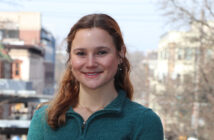Bioengineering Professors X. Frank Zhang and Wonpil Im have discovered a way to prevent the COVID-19 virus from sticking to receptors on human cells.
Im and Zhang both had experience studying proteins, but when the pandemic hit they shifted their focus. They were inspired to start their research on SARS-CoV-2 spike receptor proteins to contribute to the fight against the pandemic.
“Professor Im and I were interested in this new virus and how it worked,” Zhang said. “We wanted to know why it was so dangerous and infectious.”
While Im and Zhang were trying to find a way to prevent the virus, they also faced challenges associated with the pandemic, including a three month partial pause to their research due to lockdowns.
Once they were given permission to start working again in June, they had to pick up the pace of their research in a race against the spread of the virus.
“As (scientists) we ask the question: how can our expertise help this issue,” Zhang said.
Im and Zhang’s research focuses on “spike receptors” which are branches stemming from the center of the virus’s body. These parts of the cell are responsible for bonding with the cells in the human body, and once they have bonded, humans are able to spread and feel the effects of the virus.
Im and Zhang’s research prevents the spike receptor from binding to the cells in our body. In their experiments, they would use a COVID-19 spike receptor and would bind it to a human cell. They would then measure how much force it would take to decouple to a receptor from the cell.
What makes Im and Zhang’s research unique is that they used an experimental technique created by Zhang.
“His technique can measure the strength (of the bond) between the virus’s spike protein and the human receptor,” Im said.
Along with Zhang’s experimental technique, Im used a computational modeling simulation to provide detailed on Zhang’s experiment.
“Because of their teamwork, their findings have a greater significance and you can come to understand the issues and get a deeper answer,” said Biology Professor Vassie Ware.
The results of the experiment would not be possible without Im’s expertise in computational model simulations and Zhang’s novel single molecule detection method.
Because Im and Zhang were experimenting on how to detach the virus from the cell, their research will most likely be used as a cure to COVID-19 for those who currently have the virus, rather than a preventative method.
Although the study could have groundbreaking implications, Zhang believes that with the time it takes to develop and manufacture a new drug, their study will likely not have a tangible impact on the current pandemic.
“The time it takes to create a drug and have it pass through the FDA means that this discovery may not be able to catch this pandemic, but it will be helpful for future outbreaks,” Zhang said.
In the meantime, Im and Zhang plan on continuing their research and move onto more infectious and dangerous variants of the COVID-19 virus.






Comment policy
Comments posted to The Brown and White website are reviewed by a moderator before being approved. Incendiary speech or harassing language, including comments targeted at individuals, may be deemed unacceptable and not published. Spam and other soliciting will also be declined.
The Brown and White also reserves the right to not publish entirely anonymous comments.